Playoff Time! Puck spotlight on Duluth
By John Gilbert
Playoff hockey. There’s nothing like it. Whether it’s the state tournament in high school, or at the college level, where league, regional and national tournaments are the ultimate steps to prove superiority.
It’s been a spectacular year for hockey in the Duluth area, where superb hockey has been so widespread, it seems that some fans almost take it for granted. It started almost exactly a year ago. Last March, remember, Duluth East and Hermantown both reached the Class AA and A state tournaments, and on one excruciating day, Hermantown lost in the A title game, then East lost that overtime thriller to Eden Prairie in the AA final. Then a month later, the UMD Bulldogs won the first Division I NCAA hockey championship in the school’s history. Until Kyle Schmidt knocked in the game-winner against Michigan, the only NCAA championship banners belonging to UMD were earned by the women’s team, which won the first three NCAA tournaments, and added a fourth later.
The hockey world has turned, but Duluth remains the bright star shining in the middle of Minnesota’s universe. With section finals being conducted in Duluth this week, Duluth East ranked No. 1 among AA schools, Hermantown No. 1 among A schools, and Marshall, which doesn’t have to compete with Hermantown, was No. 1 seed in Section 7’s A bracket. All three were in the finals, one giant step away from Xcel Energy Center next week for the state tournament.
The UMD men, meanwhile, swept Colorado College last weekend in two tough games to go into this weekend’s final regular-season action at St. Cloud trailing Minnesota by two slim points for the WCHA title. The Gophers are at home against Wisconsin, which is having a rough year without a lot of talent, but which could rise up and play like the ferocious rival that emerges from the Badgers whenever they face the Gophers. While winning the league title is still there, the biggest news for UMD was a return to the No. 1 ranking in the national Pairwise calculations, which are used by the NCAA committee in selecting its national tournament teams and arranging regional pairings.
The UMD women’s team is not the best team in the country this season, and is not currently among the top eight teams, perhaps. But the Bulldogs have been playing up to their heritage in recent weeks, and last weekend’s sweep of Ohio State opened the WCHA playoffs in style. This weekend, the women’s hockey spotlight swings around to shine on Duluth, because the WCHA Final Faceoff is at AMSOIL Arena Friday and Saturday. The NCAA national Frozen Four also will be at AMSOIL two weeks from now. It would take an amazing run for UMD to reach the eight-team NCAA field. All they have to do, presumably, is beat Wisconsin and Minnesota — the No. 1 and No. 2 teams in the land.
Beating Ohio State puts the Bulldogs into position to have a chance. True, they must play their best hockey of the season in the league’s Final Faceoff, but maybe that’s how it should be. UMD will take on No. 1 ranked and regular-season champion Wisconsin Friday afternoon in the first game, while runner-up Minnesota faces North Dakota in the Friday night second semifinal. In women’s hockey, more than in men’s, big games tend to go according to form. The form chart says Saturday night’s final will be between Wisconsin and Minnesota — and if it is, Duluth hockey fans are in for a treat, because those two teams play each other with the same intensity their men’s counterparts have made an enormous tradition.
All four league semifinalists have some elite players, who must be counted on by their teams to come through under pressure. Both Minnesota — with four Patty Kazmaier Award finalists — and Wisconsin have the most high-end players in the country. Against UMD, Minnesota’s top threat is Amanda Kessel, while Hilary Knight has been unstoppable for Wisconsin against the Bulldogs. North Dakota, of course, has the Lamoureux Twins, who were dominant freshmen at Minnesota before transferring home to play for the Fighting Sioux. UMD’s catalyst is Haley Irwin, who is playing healthy and with force for her final performances in Duluth. When Irwin is in full health and fired-up, she is as good as any women’s hockey player in the country, capable of taking over any game against any opponent.
Wisconsin came to AMSOIL at the start of the season, and swept UMD. But they were highly competitive and entertaining games. In the first game, Wisconsin won 4-3. UMD’s top line got all three, although they weren’t on the same line then.Jenna McParland scored twice in the first period, with Irwin setting up both goals. Knight rose up to score late in the second period for a 3-2 lead, but Audrey Cournoyer scored in the third period to lift UMD to a 3-3 tie. A great game ended with UMD on the power play with two minutes remaining, only to have Knight get loose to score on a short-handed breakaway with 1:14 left, for the 4-3 victory.
The next day, UMD outshot Wisconsin 49-31 but lost 6-3. The game was scoreless for 17 minutes, then Hilary Knight scored on a power play at 17:05, igniting a 3-goal surge in the span of 1:34. The Bulldogs battled back, outshooting the Badgers 23-7 in the second period, but at 18:16 of that period, you got the idea it wasn’t UMD’s day. A delayed interference penalty was being called on Wisconsin’s Saige Pacholok, so UMD quickly pulled Jennifer Harss from the goal for a sixth attacker. A power-play goal could change the game, and Vanessa Thibault had possession deep in the right corner. She zipped a hard pass back to the point, where, incredibly, the puck popped over a UMD stick at the right point, and as the Bulldogs chased desperately, the puck slid all the way back and into their open goal. So at 18:16, Saige Pacholok, who touched the puck last for Wisconsin, was given credit for both an unassisted goal and an interference penalty.
Wisconsin has gone on from there to deserve the No. 1 ranking, but UMD has probably improved the most from the start of the season.To have a chance against the potent Badgers, Harss must be on her game, Jessica Wong must be at her best leading the defense, and Irwin must get her line up and flying and be the player she was when she led Canada to the last Olympic gold medal. It could be a spectacular game.
A DAY AT CLASS A
Last Thursday, it was tough to choose where to go. Hermantown had a Section 5A game against Moose Lake, Marshall had a 7A playoff against Silver Bay, and Denfeld was at Heritage playing Virginia. Because Moose Lake has the Cisar Brothers, who have scored enormous quantities this season, I headed for Hermantown. The mighty Hawks jumped ahead 4-0 and were outshooting Moose Lake 30-5.
Decision time. Hermantown’s 26th victory without a loss was assured, so I headed for the exit, missing Josh Cisar scoring his 63rd goal, which ended Hermantown’s streak of 258 shutout minutes, but couldn’t do much to prevent an 11-1 rout. There was time to get to Marshall. As I entered Mars-Lakeview Arena, Marshall scored its third goal to go up 3-0 on Silver Bay at the end of the first period. The Toppers were merciless in the second period, and the shot count rose to 47-6 by the second intermission.
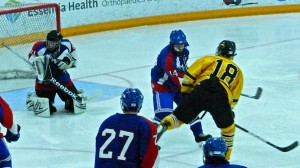
Marshall sniper Judd Peterson solved Silver Bay goaltender Alex Murray for the a goal in the 7-0 victory in 7A, but Murray, a freshman, made a state record 66 saves as Marshall outshot the Mariners 73-7.
It ended 7-0, and Marshall outshot Silver Bay 73-7, which outdid Hermantown’s 71-13. Silver Bay goaltender Alex Murray was positively brilliant, making 66 saves to break the high school record of 66 saves, which Karl Goehring established while beating Duluth East in a five-overtime state tournament game in 1996. That was the Dave Spehar East team and a five- overtime game; this was a three-period, regulation-except-for-running-time-in-the-third-period game.
Cynics who love to needle Marshall’s private-schoolness, said that Murray’s performance was so spectacular, he was No. 1 on Marshall’s recruiting list for next year. Aren’t those cynics awful?
Meanwhile, zooming down Mesaba Avenue, there was just barely time to get to Heritage Center in time to see Denfeld ‘s Levi Talarico score the final three goals in a 5-1 victory over Virginia-Mountain Iron-Buhl. But at last, it was a game without a ridiculous score, or a ridiculous number of shots. It was, in fact, a good Class A hockey game.
The beat goes on, that Hermantown and Marshall should both move themselves up from Class A to AA. Only now it is something of urgency, to save “Northern Hockey” for the future. Duluth East was the only northern team left in the 7AA semifinals. The Hounds had a narrow escape to beat Elk River 4-2 on an empty-net goal, while Andover outlasted Forest Lake 7-6 in the second semifinal at AMSOIL last Saturday. That sends Andover into the 7AA final against East’s 26-1 Greyhounds Thursday night at AMSOIL. (If you get your Reader early enough, you could still make it there.) What if it was an Andover-Elk River final? Be silly to be held in Duluth, wouldn’t it? So it’s no longer a challenge, it’s a responsibility. If Marshall moved up to 7AA, instead of rolling up 73 shots in 51 minutes against a good Class A team, and if Hermantown took its undefeated power to 7AA and let those true Class A schools have fun on their own with a chance to go to a state tournament — the reason the second class of tournaments was created — then 7AA would have East, Cloquet, Grand Rapids, Hermantown and Marshall. And we could let Elk River and Andover go back down and play in the Twin Cities against teams they face all season — where they belong, and where they’d prefer to be.
Incidentally, the problems with too many “wrong” teams playing in Class A cross over into the girls hockey, too. Remember, the purpose for having a separate class for smaller schools was to allow those schools that can’t compete with the larger schools a chance to experience the thrill of reaching a state tournament. Detroit Lakes, New Ulm, Chisago Lakes, Red Wing and Hutchinson are five perfect Class A teams, but they had to face Breck, Warroad, and South St. Paul at the Class A segment of the girls state tournament. In the first round, Warroad beat Detroit Lakes 13-1, and South St. Paul crushed New Ulm 12-1. Also, Breck whipped Chisago Lakes 7-3, and in the only game between two “true” Class A teams, Red Wing beat Hutchinson 6-5 in an overtime thriller.
In the consolation round, New Ulm beat Detroit Lakes 5-4, and Chisago Lakes beat Hutchinson 5-2. I’ll bet the girls from New Ulm and Detroit Lakes, as well as Chisago Lakes, will remember the thrill of their consolation game. What a shame they had to wait until consolation to have a real competitive game, rather than facing a small school that could well be playing and beating many of the large schools. Breck, incidentally, beat South St. Paul in a triple overtime championship game that was a great one — but both those teams should be playing “up.”
ALWAYS LOOK TO 7AA
No matter what the circumstances, you can never go wrong by making sure you get to the Section 7AA hockey playoffs, particularly the semifinals. The fact that Duluth East and Andover survived to reach this Thursday’s championship game is a significant reward.
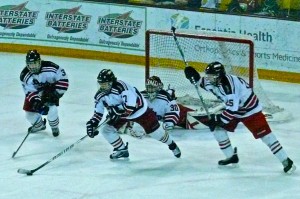
The charge starts here: East's Jack Forbort rush out from goaltender Dylan Parker, flanked by defensemen Andrew Kerr, left, and Phil Beaulieu.
East was in position to blow out Elk River in the first game. Elk River was without long-time coach Tony Sarsland, who has survived numerous controversies but can never be criticized for not having his team ready. The Elks are always in prime condition and well-disciplined. Ben Gustafson, who assisted Tony until a few years ago, came back as interim head coach while Tony fights to get reinstated.
The game opened with the Hounds at full speed. Trevor Olson, healthy and back on the top line, scored at 0:26, then defenseman Meirs Moore moved in fro the point to score with a perfect feed from Jake Randolph at 5:59. Elk River’s Mitchell Kierstad countered with a deflection goal for Elk River, but Ryan Lundgren made it 3-1 by moving up the left side, taking a pass from Alex Toscano, and drilling a shot high and in, just inside the far post. Late in the second period, still 3-1, Elk River ices the puck while killing a penalty. East goalie Dylan Parker fetches the puck deep in the right corner, turns around and lobs a soft diagonal pass across his own zone. Jared McLaughlin had to think Christmas came early, because he stepped in, intercepted the pass in the slot, and cruised to 15 feet of the open net before depositing the easiest goal he’ll ever score.
That made it 3-2, and East had to struggle to regain their poise. Coach Mike Randolph advised the team it was time to show some character, and the Hounds responded. Parker regained his touch, and even though the Elks outshot East 10-5, he held them off. In the final minute, Randolph escaped up the left boards and fired a rink-wide pass to Olson, steaming up the right boards. Elk River’s superb goaltender Andres Franke was on the bench for a sixth attacker, so Olson, a deadly shooter, had an easy target. As he closed in, however, an Elk defenseman slid across in front of him, so Olson instead made a neat pass to the slot. There was Moore, rushing up from defense, for the easy empty-netter.
“I’ve never scored an empty-net goal in high school, and I always wanted to,” said Moore, a junior, who was more genuinely excited about the clincher than his first of the game. “Me and Jake won the battle to get the puck out of our zone, Jake got it to Trevor, and I hopped up into the rush.Trevor is such a team guy; he throws that perfect ‘sauc,’ [meaning “saucer” pass] and all I had to do was put it in.”
Still, Elk River’s solid performance took away a lot of the things East most likes to do with its sharp-passing game. The automatic passing lanes that have been open all season weren’t open against the alert and disciplined Elks. “As coaches, we’re working with the seniors,” said Gustafson. “Nobody is taking any credit, and nobody is giving any blame. We all worked together.”
In the second game, Andover led 1-0, Forest Lake led 2-1, then Andover went up 4-2 with six minutes left in the second period, only to have Kyle VonTassel, Brett Gravelle and Jack Smith score power-play goals after a succession of ill-timed Andover penalties. In the third period, Andover tied it, then Tyler Tomberlin put Andover ahead 6-5 at 10:37, but Brandon Rogers came back to score at 15:29 for Forest Lake, gaining an improbable 6-6 tie. In overtime, Davis Tollette moved up to the crease and smacked in a rebound at 5:22, and Andover had its 7-6 victory.
Tollette is a perfect example of perseverence in his senior year. He hurt his ACL in football back in October, and couldn’t play until the end of January. A tall, rangy forward, Tollette was excited to play at AMSOIL Arena. “It’s the nicest ice I’ve ever skated on,” Tollette said. His name and his rangy size were both familiar to me. I coached in the Roseville Summer League for a lot of years, and brothers Jeff and Jon Tollette were both excellent players on other teams. They joined their dad to help run Bunker Hills Golf Club in Coon Rapids, one of the best golf courses in the Twin Cities. “Jeff is my dad,” said Davis Tollette, “Jon is my uncle.” Small world. Jon is now executive director at Bunker Hills.
Andover’s fourth goal, by the way, was scored when Tyler Vold flung shot from center point that found its way in. Vold, a ninth-grader who plays more like a senior, is the grandson of Jim and Laurie Knapp; he’s the former UMD assistant hockey coach, she is the principal at East.
BULLDOGS ELUDE CC
UMD’s race for the WCHA title has taken some crazy turns, but last weekend, the Bulldogs dodged a major obstacle by beating Colorado College 4-3 and 5-2. While seeming to get their game together, the Bulldogs couldn’t gain on Minnesota, which swept at Nebraska-Omaha — the most impressive Gopher weekend since Christmas.
The first CC game showed a swift but scoreless first period. Senior captain Jack Connolly scored midway through the second period, then freshmen Caleb Herbert and Justin Crandall followed for a 3-0 UMD lead on a 3-goal burst in less than five minutes. But Alexander Kryshelnyski scored in the last minute of the second period, and Michael Boivin and Rylan Schwartz scored barely a minute apart in the third period, and UMD’s 3-0 lead had dissolved into a 3-3 tie. At 3:00 of overtime, Travis Oleksuk pulled a right-corner faceoff back, and J.T. Brown blasted a one-timer from the slot past goaltender Josh Thorimbert, and UMD won 4-3.
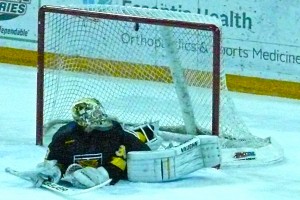
A shot by UMD's Jack Connolly hit CC goalie Josh Thorimbert and popped up, just under the crossbar, before landing in the goal.
The next night, UMD was more assertive against the speedy Tigers, and a record home crowd of 6,808 turned out to see everybody get involved in the scoring. Mike Seidel scored twice, putting UMD up 1-0 in the first, and 2-1 in the second; Brown got another, making it 3-1 after two, and so did Herbert, making it 4-1 before Oleksuk made it 5-1 in the closing minutes. A late CC goal made it 5-2. Connolly, still a favorite for Hobey Baker, had three assists. His first was a work of art, but subtle, as he rushed up the right side, letting Keegan Flaherty drive the defense toward the net before hitting Seidel, who fired from the right faceoff circle and caught the far edge. With 1:06 to go, on the power play, Oleksuk rushed up the middle and fed Connolly on a 2-on-2. Connolly flipped a soft lob pass ahead, across the slot, and, sure enough, Oleksuk broke hard and deflected it in.
Coach Scott Sandelin has to worry about who will make those neat, subtle plays next season, after Connolly’s gone, but for now, we can all enjoy watching his artistry. UMD paid tribute to seniors Connolly, Oleksuk, forward David Grun, defensemen Brady Lamb and Scott Kishel, and goaltender Kenny Reiter. Lamb said, “This was closer to the way we played when we were on our streak. We’d been giving away points, but tonight all of our lines and our defense as well got in the scoring…and even Kenny.” Sure enough, Reiter assisted on Seidel’s first goal and on Brown’s goal. Cody Danberg, who missed last year with an injury, and also was injured for his red-shirt return year, also was introduced with the seniors. While it was the last regular-season series for the seniors, the Bulldogs will, of course, be back in AMSOIL next weekend for league playoffs.
Men’s traditions don’t fit women’s hockey
By John Gilbert
Back in the late 1980s, Rochester John Marshall reached the Minnesota state high school hockey tournament led by a pair of defensemen, Doug Zmolek and Eric Means. They were a Mutt and Jef defensive tandem, with Zmolek a 6-foot-2 specimen already being eyed by the NHL, and Means a stocky 5-foot-8. But they both had all the tools, offensively and defensively.
While covering all levels of hockey for the Minneapolis Tribune in those days, I always seemed to pick out players who might be overlooked, but whose play I admired, and I’d keep an eye on them. Means was my guy back in the 1988-89 season, when JM went all the way to the title game before falling 5-4 in overtime to Bloomington Jefferson. Both Zmolek and Means went on to play for the Gophers. Zmolek left early to sign a pro contract. Means, always in the background, overshadowed by bigger stars, played all four years and was outstanding.
Hockey hasn’t changed a lot from those days, with almost all North American men’s hockey following the old Canadian tradition of teams trying to prove they’re better than their foes, and if they can’t do it with skill, they might try to beat on that foe physically. If you can intimidate an opponent’s players, get them off their game, you’ve got a good chance to beat them. That Canadian style, up and down lanes, dumping the puck in, pressing and hoping for a lucky turnover to get a scoring chance, and playing tough, all the time, has prevailed.
Along with that, men developed some unwritten rules: You don’t try to show up an opponent, you don’t try to rub it in, and if you offend an opponent, be prepared for them to react aggressively — maybe with a bodycheck, maybe with a cheapshot, maybe with subtlety, or maybe with ugly openness.
That has always been one of the refreshing differences between men and women playing the game. Nobody could have envisioned women’s hockey’s emergence, sweeping Minnesota high school girls into a new form of competition, and finding their pinnacle in college hockey, or Olympics. Bodychecking, as the men know it, is not allowed, although there is plenty of meaningful contact to stop or squeeze off a foe. Imagine a men’s game where the players had to avoid the high-speed charges, crosschecks and intent-to-injure killshots. Or a departure from the macho coach who sees his team team as less-skilled and tells his players to “run ’em!” Instead, if men’s coaches had to confront skilled teams with tactics and creativity, it might be a better game.
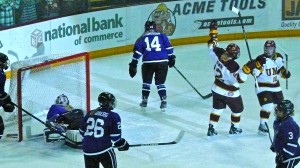
Haley Irwin (10) congratulated Audrey Cournoyer, who scored twice in UMD's 4-1 victory over MSU-Mankato.
The Women’s WCHA has evolved from a decade ago, when some of the teams had players who could barely skate, couldn’t shoot, and barely understood how to get out of their zone. UMD got the drop on the whole league by hiring Shannon Miller, a tough, aggressive woman who had coached the Canadian Olympic team that was upset by the U.S. in the gold medal game at Nagano, Japan, a year earlier. Miller and the Bulldogs won the first three NCAA women’s tournaments ever held.
Miller proved to be a rare combination of a Bulldog and a wildcat, at the same time, and was clearly the best coach in the Women’s WCHA. As always, if the teams are similar in talent level, the games can be exciting and highly competitive, but UMD had to find a Minnesota, or a Harvard, or later Wisconsin, to extract its highest level of play. A decade later, the competitive level of the WCHA is better than ever. The bottom teams can now challenge the top teams — as they will attempt to prove in the first round of WCHA playoffs.
Blatant physical intimidation tactics simply don’t happen in women’s hockey. Nobody raises an eyebrow if a superior team keeps scoring to the end of a one-sided game, although generally, teams don’t try to pile up the goals. Maybe making plays and scoring to the end is less of an insult than a pulling up and obviously trying not to score.
One very interesting and enormous change in the Women’s WCHA is in coaching. Of the eight WCHA teams — UMD, Minnesota, Wisconsin, Ohio State, St. Cloud State, Bemidji State, North Dakota, and Minnesota State-Mankato — seven have had a woman head coach at some time or other. The only one that hasn’t is MSU-Mankato. Of the other seven, Shannon Miller remains as the only female head coach in the league. Think about that.
Nobody can criticize the job done by Mark Johnson at Wisconsin, Steve Sertich at Bemidji State, or Brad Frost at Minnesota, but it is interesting that all of these grand institutions have been unable to find a woman to coach young women. Therefore it shouldn’t be surprising that Shannon Miller accrues more criticism than all the other coaches combined. Maybe, from a league traditionally run by men and from a coaching fraternity of all men, it should be expected that other might resent the amazing success and bold demeanor of the only female coach. Usually the blend is smooth, but not always.
Modern women’s hockey, and traditional men’s “by the book” hockey came to a passionate collision in the last weekend of the regular 2011-12 season at AMSOIL Arena. UMD’s Bulldogs needed to win to assure the fourth and final home-ice spot, and faced last-place Minnesota State-Mankato. The Mavericks are now coached by Eric Means, one of my former favorite players, who switched after years of assisting Troy Jutting with the Mavericks men to take on the head women’s job a few years ago. Jon Austin, former International Falls and Colorado College star, hired on as assistant. It’s been a tough year for the Mavs, whose deficiencies need improvement at every position. But they try hard.
The Friday game started, and UMD’s Audrey Cournoyer scored on a quick rebound of a Haley Irwin shot at 0:45. The Mavericks tied it when Kari Windberg scored midway through the first period, but Shara Jasper puts UMD ahead again, and Cournoyer’s second of the game made it 3-1 after one. Irwin, who assisted on both Cournoyer goals, scored in the second period to make it 4-1. Shots were pretty even, a credit to the Mavericks, but they couldn’t score any more on Jennifer Harss, so the game headed for a 4-1 finish. Cournoyer had a couple chances for a third goal. From the press box, I didn’t realize that Irwin had reached 199 points for her four years at UMD.
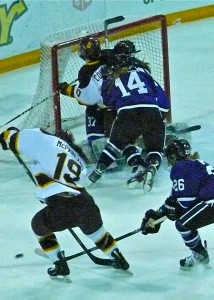
MSU-Mankato defenseman Erika Magnusson (14) shoved Audrey Cournoyer into the goalie as Jenna McParland (19) tried to corral the rebound.
In the final minute of play, Shannon Miller called a time out. UMD has had the tendency to lapse this year, and mind-reading from the press box, my thought was that Miller might well be suggesting a strong finish this time, to get into playoff mode. She sent out her first line. Almost immediately, MSU-Mankato’s Kelsie Scott was whistled for cross-checking. It was a forceful hit, could have been checking from behind, and it put UMD on the power play with 24 seconds remaining. If the plan was to get Irwin her 200th point, or Cournoyer her hat trick, it didn’t seem like a big deal.
The clock ticked down into its final 10 seconds, and Irwin rushed with the puck up the left side, where she met some congestion at the left circle. As she slowed, suddenly, Lauren Smith, a junior first-line wing from MSU-Mankato, blasted Irwin, knocking her face down to the ice. The blow was an apparent wildly flung elbow flipper that struck Irwin on the helmet. As Irwin dropped to all fours, Cournoyer picked off the puck — remember the puck? — and darted in from the circle, all the way to the net. She tried to jam in a shot but was stopped. Mavericks defenseman Erika Magnusson shoved Cournoyer over goaltender Alli Altmann, but Cournoyer held her balance.
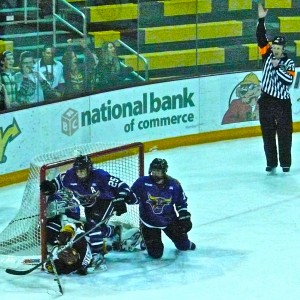
Lauren Smith (25) peeled off after cross-checking Audrey Cournoyer from behind into the crossbar as the clock reached 0:00 in the 4-1 UMD victory.
In the next instant, Cournoyer was blown away by a high-speed cross-check from behind, flying helmet-first into the crossbar, and down, as the clock reached 0:00.
The two coaches came off their adjacent benches and it was clear they were discussing things in a hostile manner. I have seen Shannon Miller go after people to make a point, and I wondered if that was the case this time. “I came out to shake hands, as I always do,” said Miller. “He said, ‘Nice time-out, you (bleeping) (bleep).” From there, the conversation turned south, apparently. Miller claims that when she expressed outrage that Irwin might be seriously hurt, Means said something like, “Good, I hope she has a separated shoulder.” A photographer stationed nearby, between the benches, pretty much corroborated Miller’s recounting of the situation, although the language was not fit for family consumption.

UMD coach Shannon Miller glared at MSU-Mankato coach Eric Means, left, after their volatile post-game conversation.
Meanwhile, UMD’s plan was to recognize its top student-athletes after the game, and all those with a 3.5 or higher grade point average lined up on the blue line. That created a bizarre scene: UMD trainer Beth Clute helping Irwin struggle to her feet, and off to the dressing room; game officials huddling by the scorer’s table to figure out the penalties; and the scholar-Bulldogs standing on the blue line, waiting for about 10 minutes.
The public address announcement said: “Penalty at 20:00 to the Mavericks No. 25, Lauren Smith, 5-minute major penalty and game misconduct, for contact to the head.” But when he went to repeat it, it changed to, “The Mavericks No. 25, Lauren Smith, 5-minute major penalty and game disqualification for checking from behind.”
Well, I asked, which is it? Turns out, it was both. Lauren Smith, who had KO’d Haley Irwin with an elbow to the head, then raced to the crease in time to blast Cournoyer into the crossbar.
Before I spoke with Miller, I stopped at the much more accessible visiting team corridor and waited. Means and Austin came out, and I renewed acquaintances with two former players who are now old friends, in a private and exclusive interview.
“Your team played a heck of a game, until the last shift,” I said, “then your No. 25 seemed to lose it. What happened?”
Means launched into a mini-tirade; notebook ready, I tried to write it all down.
“Taking a time-out with 40 seconds left? That’s bullshit,” Means said. “On the bench, I said, if they put No. 12 out there, run over her.”
I stopped Means. “Are you kidding? Did you really tell your players to run UMD’s top player?” As it turned out, Smith took out UMD’s top two forwards, which should put her in the WCHA record book somewhere, with two 5-minute majors, a game misconduct and a game disqualification, with her double-barreled attack at 20:00.
“I’m proud of her and I wish she could play tomorrow night,” Means said, meaning Saturday’s rematch.
Without any knowledge that Means had essentially admitted he sent his players out after UMD’s top stars, Miller was livid. She said she was going to file a report. The WCHA generally sends such reports back to member institutions to enforce any further discipline. It could become a he-said, she-said issue — for those who weren’t in attendance.
In my completely private interview with Means, I repeatedly asked if that sort of attack wasn’t something from “the book” of men’s hockey, an ugly part of pro, or junior, or college, or even high school hockey, but which seems out of bounds — way out of bounds — in women’s hockey.
“Well,” said Means, “then don’t put your best players out there for the last 40 seconds when it’s 4-1.”
The next night, Jamie Kenyon scored twice in the first three minutes for UMD, then Irwin scored on a power play, and celebrated a little extra with her fist pumps, as she headed back toward her bench. On the way, she had to pass the MSU-Mankato bench, and maybe it just seemed like Irwin paused in that vicinity to make sure the Mavericks knew she had gotten her goal, after all.
The Bulldogs went on to win 7-1 to complete the sweep, and now it’s on to playoffs. UMD is at home against Ohio State Friday night and Saturday afternoon, and Sunday if necessary, while MSU-Mankato heads for league champ Wisconsin. St. Cloud State is at Minnesota, and an extremely interesting series finds Bemidji State at North Dakota. We can hope that the long-standing difference between the “unwritten rules” of men’s and women’s hockey might return to the women’s normal form, because some traditions just aren’t worth continuing.
BMW 3-Series dazzles at introduction
By John Gilbert
MONTEREY, CALIF. — All is fair in love, war, and new car introductions, apparently. But if it’s BMW, some things seem unfair. BMW summoned North American auto writers for first test-drives of the sixth generation BMW 3 Series. We knew going in we were going to be driving the latest iteration of a sedan that every other car maker identifies as the benchmark they used for any new vehicle.
First impression shows a refined kidney-shaped grille, with headlights that are stretched horizontally, enclosed in an elongated housing that reaches from the outer edges to the grille, and they are overlined with a sloping line that changes the personality of the car. BMWs always have looked a little bit like raptors, face on, and the new 3 looks more like an extra-aggressive and maybe hungry raptor on the prowl, capable of diving and pouncing on its prey from wherever it chooses.
It looks larger because it is, and its power now comes from a pair of highly refined turbocharged engines — either a 2.0-liter 4-cylinder, giving the 328 model 240 horsepower at 5,000 RPMs and 260 foot-pounds of torque at a mere 1,250 RPMs, or the familiar 3.0-liter in-line 6, with 300 horsepower at 5,800 RPMs and 300 foot-pounds of torque holding that peak from 1,250 to 5,000 RPMs. A 6-speed manual or 8-speed automatic — smooth-shifting, but not a direct-sequential twin-clutch device — which can be upgraded to a sport package with steering wheel paddles to manually make or hold shifts. The smooth abundance of power indicates BMW has maintained its perch at the top of my personal rating of auto-world technology.
There are three trim groupings, with the Sport Line identifiable by 8 high-gloss black vertical bars in its grille, the Luxury Line with 11 chrome bars, and the Modern Line with 11 satin-silver bars. There are more exceptions than models, however, because you can get the 4 or the 6 in any version, and you can upgrade to sport application if desired. Also, a wagon version is coming, and so are a hybrid, a pure-electric version, and the highest-performing M3, all of which should be showing up by the end of summer. There will be no diesel for the 2012 calendar year.
Prices provoke my old axiom for BMW. The 328i with the 4 starts at $35,795, and the 335i with the 6 starts at $43,295. My axiom about the cost of a BMW: “Exorbitantly priced, but worth every penny.” Read more
Chicago Auto Show: Less news, more fun
By John Gilbert
CHICAGO, ILL. — The 2012 Chicago Auto Show — which runs through the weekend of February 19-20 — is not the site of a lot of strikingly new vehicles, but it easily maintains its position as the most casual and most fun of the “big four” U.S. auto shows. The setting was a good opportunity for Ford and Chrysler to show off future stars, with Ford’s 2013 Fusion and the 2013 Dodge Dart both being built in the Chicago area, within shouting distance of McCormick Place.
This is the 100th Chicago Auto Show, and it runs through the February 18-19 weekend, presenting a wide array of the newest and hottest products in the auto world. In that category are Hyundai, from South Korea, by way of Montgomery, Ala., and Volkswagen, from Germany, by way of Chattanooga,Tenn., which have evidence of rising to the top of the industry by winning awards even while promising to win more.
Just when it seems that Hyundai might pause to reflect on the North American Car of the Year award presented to its compact Elantra in January at the Detroit show, Hyundai instead stole much of the media-day show by unveiling two new models of the new Elantra — a flashy 2-door sporty coupe, and a 5-door hatchback Elantra GT, with a special sporty stance, suspension and flavor.
Top Hyundai executives John Krafcik and Michael O’Brien took turns at the podium. Krafcik said while enjoying the awards, the Elantra added an achievement in a Popular Mechanics comparison of cars that can reach 40 miles per gallon in real-world driving. “Compared to the Ford Focus, it was pretty close,” said Krafcik. “The Elantra got 47.6 mpg in the test, and the Focus got 47.5, at 55 miles per hour. But at 70 mph, the Elantra got 39.3 mpg, and the Focus 33.5. Our biggest problem is we can’t build enough of them at our Montgomery plant.”
With that, out came the new coupe and the GT, rolling on-stage simultaneously from opposite ends to flank the award-winning sedan. O’Brien said: “The Elantra now is the only compact with three styles — the sedan, coupe, and [5-door] GT.” Read more


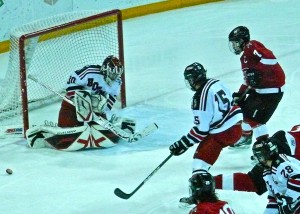



 John Gilbert is a lifetime Minnesotan and career journalist, specializing in cars and sports during and since spending 30 years at the Minneapolis Tribune, now the Star Tribune. More recently, he has continued translating the high-tech world of autos and sharing his passionate insights as a freelance writer/photographer/broadcaster. A member of the prestigious North American Car and Truck of the Year jury since 1993. John can be heard Monday-Friday from 9-11am on 610 KDAL(www.kdal610.com) on the "John Gilbert Show," and writes a column in the Duluth Reader.
John Gilbert is a lifetime Minnesotan and career journalist, specializing in cars and sports during and since spending 30 years at the Minneapolis Tribune, now the Star Tribune. More recently, he has continued translating the high-tech world of autos and sharing his passionate insights as a freelance writer/photographer/broadcaster. A member of the prestigious North American Car and Truck of the Year jury since 1993. John can be heard Monday-Friday from 9-11am on 610 KDAL(www.kdal610.com) on the "John Gilbert Show," and writes a column in the Duluth Reader.